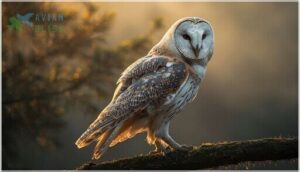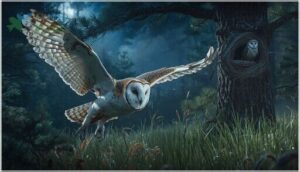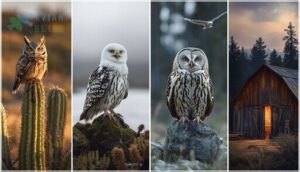This site is supported by our readers. We may earn a commission, at no cost to you, if you purchase through links.
An owl can spin its head 270 degrees in either direction—nearly three-quarters of a full circle—without cutting off blood flow to its brain. This extraordinary feat is possible because owls have twice as many neck vertebrae as you do, along with specialized blood vessels that create reservoirs to maintain circulation during extreme rotation. But flexible necks are just the beginning of what makes these raptors so unusual.
From tube-shaped eyes that can’t move in their sockets to asymmetrical ears positioned at different heights on their skulls, owls are built like no other bird on Earth. These adaptations turn them into precision hunters capable of swooping silently through darkness and pinpointing a mouse’s heartbeat beneath snow.
Here are the most fascinating facts about owls that reveal why these birds have captivated scientists and cultures for thousands of years.
Table Of Contents
- Key Takeaways
- Remarkable Owl Anatomy and Senses
- Intriguing Owl Behaviors
- Diversity Among Owl Species
- Cultural Significance of Owls
- Conservation and Ecological Impact
- Frequently Asked Questions (FAQs)
- What is a unique fact about owls?
- Why are owls special to people?
- What does an owl symbolize?
- Why are owls mysterious?
- Are owls nocturnal?
- Can owls turn their heads all the way around?
- Do owls have good eyesight and hearing?
- Where do owls live and build their nests?
- How long do owls live?
- How long do owls live in the wild?
- Conclusion
Key Takeaways
- Owls can rotate their heads 270 degrees thanks to 14 neck vertebrae (double what humans have) and specialized blood vessels that maintain circulation during extreme rotation, preventing brain damage.
- Their hunting precision comes from tube-shaped eyes that can’t move but provide powerful binocular vision, asymmetrical ears positioned at different heights for 3D sound tracking, and specialized feathers that create completely silent flight.
- A single barn owl captures over 1,000 rodents yearly, making these nocturnal predators worth thousands of dollars to farmers as natural pest controllers who reduce crop damage without chemicals.
- About one-third of the world’s 200+ owl species face serious threats from habitat loss and climate change, with some populations dropping over 50%, making conservation efforts critical to protecting these ecosystem balancers.
Remarkable Owl Anatomy and Senses
Owls possess some of the most specialized anatomy in the animal kingdom, with adaptations that seem almost impossible. From their famously flexible necks to their silent wings, each feature fulfills a precise purpose in their survival.
Let’s explore the extraordinary physical traits that make owls such effective hunters.
Their silent flight, razor-sharp talons, and binocular vision combine with distinct physical differences and hunting strategies that separate species like barn owls from great horned owls.
Extraordinary Neck Rotation
You’ve probably wished you could see behind you without turning around—owls actually can. Their neck flexibility allows them to rotate their heads about 270 degrees, thanks to 14 cervical vertebrae (double what humans have). This exceptional joint structure, combined with precise musculature control and a specialized vascular system, lets them track prey while staying perfectly still.
Understanding language patterns is also essential for humans to learn about unique traits like this.
Unique Eye Structure and Vision
While neck rotation helps owls scan their surroundings, their eyes reveal an even stranger adaptation. You’re looking at tube-shaped eyes fixed completely in their sockets—no side-to-side glances possible. This unique eye anatomy creates powerful binocular vision for pinpoint depth perception. Their retinas pack densely with rod cells, giving nocturnal birds superior low light adaptation. That’s night vision perfected through evolution.
- Forward-facing eyes enable precise depth judgment during hunts
- High rod cell concentration maximizes light capture in darkness
- Specialized photoreceptors improve motion detection at night
Asymmetrical Ears and Superior Hearing
Beyond those fixed eyes, owls deploy asymmetrical ears for remarkable sound localization. One ear opening sits higher than the other on your owl’s head, enabling vertical acoustic tracking. Their facial disk funnels sounds inward like a satellite dish, while different ear shapes improve binaural hearing mechanisms.
This acute hearing lets owls pinpoint prey rustling beneath snow—auditory perception refined to an optimal level through specialized ear anatomy. The unique hearing system of owls can be compared to sophisticated methodological assessment techniques used in scientific research.
Specialized Feathers for Silent Flight
Owl feathers create silent flight through intricate aerodynamic adaptations. Velvety front-edge barbules on their wings form soft air cushions, while frayed feather fringes disrupt turbulent airflow.
These adaptations help owls hunt undetected, making them essential predators in habitats you can support by creating a bird-friendly environment.
These specialized structures in avian biology work like acoustic dampeners—asymmetric rachises and precise feather spacing minimize the sandwich-like turbulence typical in bird characteristics.
Coating microstructures trap air to cushion wingbeats, letting nocturnal animals approach prey undetected through refined flight mechanics and unique wingbeat patterns.
These adaptations hold deep meaning in many regions, as owl symbolism across African cultures reveals how silent flight shaped spiritual beliefs about wisdom and ancestral communication.
Powerful Zygodactyl Feet
You’ll find talons arranged in a zygodactyl pattern—two toes forward, two back—engineered for precision prey capture. This foot mechanics design, a standout in bird characteristics, delivers crushing grip strength up to 300 PSI.
The ankle mobility acts like a hinge, positioning claws for ambush strikes. It’s avian biology refined for owl behavior: grasp, immobilize, secure—all before prey realizes the hunt began.
Intriguing Owl Behaviors
Owls aren’t just skilled hunters—their daily lives reveal some of nature’s most surprising patterns. From their hunting schedules to their family dynamics, these birds follow behaviors that set them apart from most other raptors.
Let’s look at five intriguing aspects of how owls live and thrive in the wild.
Many species also benefit from artificial nesting structures, and installing owl nesting boxes in your region can provide safe breeding sites where natural cavities are scarce.
Nocturnal and Crepuscular Hunting
When darkness falls, you’ll find these outstanding nocturnal animals at their most active, relying on silent flight and superior prey detection to survive. Their nighttime hunting prowess stems from specialized adaptations:
- Night vision and owl vision capture available light through large, tube-shaped eyes that enable precise strikes in near-total darkness
- Acoustic cues from asymmetrical ears pinpoint prey movements with three-dimensional accuracy
- Hunting strategies shift between nocturnal and crepuscular patterns, maximizing success during dawn, dusk, and darkest hours
Solitary Vs. Social Habits
Unlike most birds, you’ll notice owls prefer solitary hunting and territorial behavior throughout their lives. Each adult defends its own owl habitat using owl communication—hoots and calls—to maintain boundaries.
While a few species form temporary group dynamics during breeding, social bonds remain minimal.
This solitary lifestyle reflects their specialized animal behavior and influences wildlife conservation strategies that protect individual territories rather than colonies.
Unique Nesting and Parenting Practices
You won’t find owls building elaborate nests—most species reuse abandoned cavities or claim nests from other birds. Nest site selection depends on prey availability and shelter quality.
Parental roles divide clearly: females incubate clutches of 2 to 6 eggs for 28 to 32 days while males deliver food. After hatching, both parents provide fledgling care until young owls fly at 20 to 40 days old.
Monogamous Mating and Lifelong Pairs
Many owl species take the phrase “till death do us part” seriously—you’ll discover lifelong monogamy across numerous populations. Pair bonding stabilizes territories and boosts breeding success through coordinated hunting and synchronized parental care.
- Mate Selection: Partners reunite across multiple breeding seasons in stable habitats.
- Nest Defense: Both adults protect territories and coordinate incubation duties.
- Foraging Partnerships: Tandem hunting improves prey capture efficiency.
- Breeding Success: Lifelong pairs produce higher cumulative fledgling counts.
- Genetic Diversity: Repeated compatibility maintains healthy offspring variation in owl species.
Pellet Production and Diet
You’ll notice owls regurgitate pellets—compact masses of undigested bones, fur, and teeth—shortly after feeding. This regurgitation process reveals fascinating dietary habits through pellet analysis, allowing researchers to identify prey selection patterns across species.
Small mammals, birds, and insects dominate owl prey, while efficient nutrient absorption occurs before expulsion. These birds of prey produce multiple pellets weekly during the breeding season, offering valuable insights into owl biology and behavior.
Diversity Among Owl Species
Owls aren’t just one-size-fits-all nocturnal hunters—they’re a remarkably diverse group with over 220 species spread across the globe. From tiny desert dwellers to massive forest predators, you’ll find owls adapted to nearly every habitat on Earth except Antarctica.
Let’s look at the astonishing variety within this fascinating bird family and what makes each species unique.
Number and Types of Owl Species
You’ll find about 200 distinct owl species worldwide, organized into two families: Tytonidae (barn owls) and Strigidae (true owls). This owl species classification reflects notable habitat diversity and species adaptation across continents except Antarctica.
Ongoing ornithology research continues refining bird species counts using molecular data. The IUCN monitors conservation status closely, as several owl species face threats from habitat loss, making global distribution patterns vital for animal facts and owl biology studies.
Smallest and Largest Owl Varieties
Owl size comparison reveals striking extremes. The elf owl stands just 5–6 inches tall and weighs 1.5 ounces, while the great gray owl reaches 32 inches with massive wing span variations.
Feather adaptations and beak structure differ accordingly—barn owls and other owl species show specialized hunting styles tied to owl biology.
These differences reflect environmental pressures shaping each bird’s survival strategy.
Migration and Range Adaptations
Beyond physical differences, migration patterns and range shifts reveal how owls respond to seasonal changes. Some boreal species travel thousands of miles along established flyways, while others remain resident. Climate adaptation drives these movements—altering habitat use, prey availability, and breeding grounds.
Migration and range adaptations include:
- Seasonal flyway conservation protects corridors across continents
- Range shifts follow temperature and prey phenology changes
- Partial migrants adjust movements based on local food abundance
Specialized Hunting Abilities
You’ve seen how owls adapt to territory and climate—now picture the precision behind each strike. Silent flight lets them approach undetected, while acute hearing pinpoints rustling prey meters away.
Owl eyes gather maximum light for night vision, and asymmetrical ears map sound in three dimensions.
These birds of prey combine sensory mastery with stealth, making every hunting strategy devastatingly effective.
Endangered and At-Risk Species
Survival hangs in the balance for about one-third of the world’s owl species. The IUCN Red List shows 27 threatened species face habitat loss and declining prey, while population monitoring reveals drops exceeding 50% for some. Conservation efforts now prioritize habitat preservation and threat assessment:
- Reforestation projects restore critical nesting zones
- Species research tracks migration and breeding success
- Wildlife conservation programs protect vulnerable populations
You can help endangered species by supporting these initiatives.
Cultural Significance of Owls
Owls have captured human imagination for thousands of years, appearing in myths, art, and folklore across every continent they inhabit. Different cultures have assigned vastly different meanings to these nocturnal birds—from divine protectors to harbingers of doom.
Let’s explore how owls have shaped beliefs and symbolism throughout human history.
Symbolism in Mythology and Folklore
Throughout history, owls have been woven into mythology as powerful symbols with shifting meanings. In ancient Greece, they represented Athena’s wisdom, while the Aztecs and Mayans connected them to death and destruction. The Ainu people of Japan revere the Blakiston’s fish owl as “the Emperor of the Night,” and in South Africa, owl mythology links these birds to witchcraft.
Here’s how cultural significance varies:
| Culture | Symbolic Meanings |
|---|---|
| Ancient Greece/Rome | Wisdom, omens, strategy |
| Aztec/Mayan | Death, darkness, destruction |
| Japanese Ainu | Divine protection, night guardianship |
| Australian Wardaman | World creation, cosmic power |
| South African traditions | Witchcraft, misfortune, supernatural forces |
These mythical creatures embody humanity’s fascination with owl biology and behavior, transforming nocturnal hunters into symbols that reflect our deepest beliefs about knowledge, mystery, and the unseen world.
Representation in Art and Literature
From ancient Greek pottery to Renaissance paintings, artistic depictions capture owls as cultural icons representing wisdom and mystery. Literary appearances span centuries—Henry David Thoreau observed their symbolic meanings in nature writing, while medieval bestiaries explored mythological significance.
You’ll find owl behavior reflected in modern graphic novels and film, where symbolism connects mythology to today’s environmental awareness, transforming these nocturnal hunters into timeless emblems of knowledge and intuition.
Traditional Beliefs and Superstitions
In many cultures, owl mythology carries powerful symbolism—from ancient legends linking them to death omens and evil spirits to folklore significance as messengers between worlds. Traditional beliefs reflect this duality: while some civilizations revered owls as cultural symbols of protection, others feared them as harbingers of doom.
Understanding these ancient legends enriches wildlife conservation efforts by connecting modern science to humanity’s long relationship with these extraordinary birds.
Owls as Emblems of Wisdom and Mystery
You’ve probably noticed owls on academic logos and in children’s books—that’s Wisdom Symbolism at work. Their Cultural Significance stems from Mythic Origins linking them to Athena in ancient Greece.
Yet owls also carry a Mystery Aura, portrayed as nocturnal guardians of secret knowledge. This Emblematic Meaning shapes how we view Owl Behavior and Characteristics, blending Mythology and Folklore with real Animal Adaptations into compelling Owl Facts.
Conservation and Ecological Impact
Owls aren’t just fascinating creatures—they play a critical role in keeping ecosystems balanced and healthy. However, many species face serious threats that put their survival at risk.
Understanding their ecological impact and the challenges they encounter can help you appreciate why protecting these extraordinary birds matters so much.
Owls as Natural Pest Controllers
You mightn’t realize it, but owls are nature’s own pest management system. These birds of prey help maintain ecological balance by consuming over 1,000 rodents yearly per barn owl.
Owls are nature’s pest management system, consuming over 1,000 rodents yearly per barn owl to maintain ecological balance
Their biological control services reduce crop damage in some regions. Conservation efforts that protect owl habitats—like installing nesting boxes—support this natural pest control while preserving wildlife conservation values and fascinating animal behavior.
Threats From Habitat Loss and Climate Change
While owls excel at controlling pests, habitat fragmentation and climate shifts threaten their survival. You’ll witness biodiversity loss as deforestation removes nesting sites and reduces prey availability. Ecosystem disruption follows when:
- Urban development destroys wildlife habitat
- Temperature changes alter breeding cycles
- Extreme weather increases nest failures
- Wetland drainage eliminates hunting grounds
Conservation strategies focused on wildlife conservation and protecting animal adaptations remain essential for owl ecology.
The Importance of Research and Awareness
Research methods and wildlife research and studies reveal that awareness campaigns boost threat reporting by 20–35% and cut human–owl conflicts by 40%. Education initiatives paired with bird watching and observation teach real conservation efforts. Community engagement through citizen science turns environmental awareness into action—nest boxes installed, habitats restored. Wildlife conservation efforts succeed when data is translated into protection.
| Research Benefit | Measurable Impact |
|---|---|
| Awareness campaigns | 20–35% increase in reporting |
| Community engagement | 40% reduction in conflicts |
| Education initiatives | 15–25% better species recognition |
| Conservation efforts | Higher long-term survival rates |
Frequently Asked Questions (FAQs)
What is a unique fact about owls?
You might think turning your head 270 degrees would cut off blood flow, but owls have a specialized blood-pooling system that keeps their brain and eyes functioning during dramatic neck rotations.
Why are owls special to people?
Cultural symbolism elevates these raptors beyond wildlife into human fascination. You’ll find owl mythology spanning continents—from wisdom emblems to conservation mascots.
Their ecological importance, nocturnal mystery, and cultural significance inspire falconry traditions and bird conservancy efforts worldwide.
What does an owl symbolize?
Across cultures, owls symbolize wisdom and knowledge. They represent mystery, intuition, and vigilance. In mythology, owls serve as spiritual messengers. Their symbolic meanings span protection, education, and moral caution.
Why are owls mysterious?
Their silent flight, nocturnal habits, and cryptic plumage create an elusive nature.
You’ll find their adaptive abilities—asymmetrical ears for precise owl hearing and specialized owl vision—make these mysterious traits fascinating across nocturnal owl behavior and characteristics.
Are owls nocturnal?
Most owl species are nocturnal, hunting under cover of darkness with remarkable night vision and hearing.
However, some exhibit crepuscular activity, becoming most active during twilight hours when certain prey emerges.
Can owls turn their heads all the way around?
You might think owls can spin their heads 360 degrees, but they actually rotate about 270 degrees.
Their specialized vertebral arteries and fourteen neck vertebrae enable this extraordinary head turning while maintaining brain perfusion.
Do owls have good eyesight and hearing?
You’ll find their sensory adaptations are remarkable. Visual acuity peaks at night through massive owl eyes capturing dim light, while auditory capacity thrives via asymmetrical owl ears enabling precise sound localization—both vision and hearing excel for hunting success.
Where do owls live and build their nests?
You’ll discover owls nesting everywhere—woodlands bursting with tree cavities, cliff ledges, prairie dog burrows, even your neighborhood barn.
Urban roosting and habitat fragmentation push these adaptable hunters into surprising spaces when natural wildlife habitat disappears.
How long do owls live?
Small owls usually survive 4 to 10 years in the wild, while medium-sized species reach 10 to 20 years. In captivity, many live past 30 years due to stable food and protection from predators.
How long do owls live in the wild?
Most wild owls live just 4 to 10 years, though wild mortality rates hit juveniles hardest.
Habitat influence and species longevity vary—great horned owls often reach a decade, while smaller species average less.
Conclusion
A single barn owl can catch over 1,000 rodents per year, making it worth thousands of dollars to farmers who would otherwise use pesticides.
These fascinating facts about owls reveal birds engineered by evolution into living sensors—each feather, bone, and nerve tuned for survival.
By protecting their habitats and supporting conservation efforts, you’re safeguarding creatures that balance ecosystems while reminding us that nature’s solutions often surpass anything we could design ourselves.













